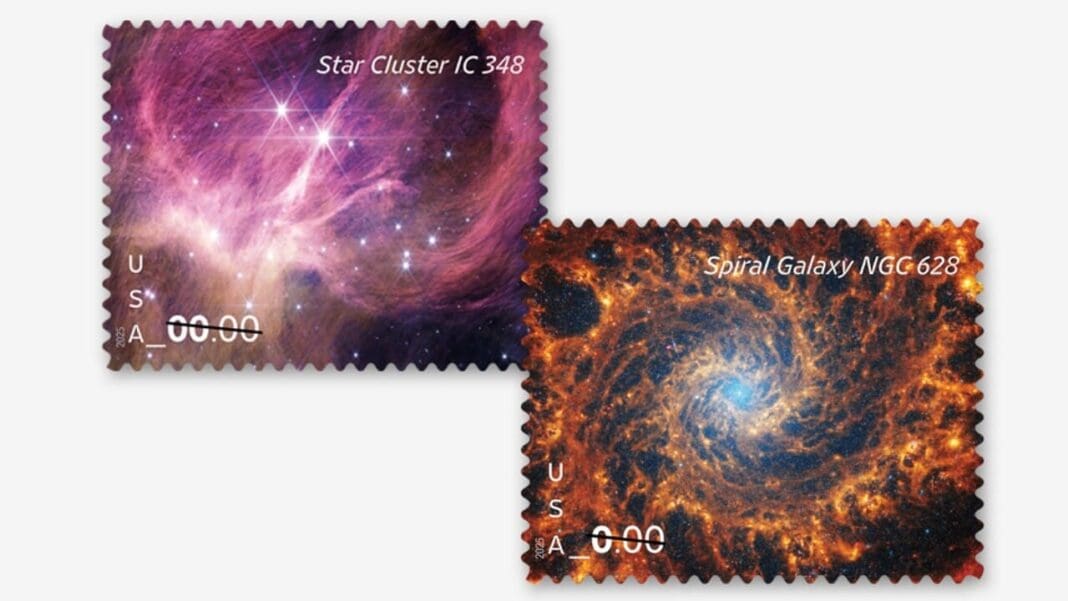Two new Priority Mail and Priority Mail Express stamps went on sale today at the Big Sky, MT, Post Office.
Customers and collectors can purchase the stamps, get a special commemorative first-day-of-issue postmark and see large display images of the stamps in the Post Office retail lobby.
The two new stamps celebrate America’s continued exploration of deep space with extremely high-definition images captured by NASA’s James Webb Space Telescope using its Near-Infrared Camera and Mid-Infrared Instrument.
Spiral Galaxy
The captivating image on the new Priority Mail stamp shows spiral galaxy NGC 628, located 32 million light-years from Earth in the constellation Pisces.
The blue light within the hazy circular core at the center of the image represents clusters of older stars. The Webb Telescope’s infrared cameras penetrating thick clouds of gas and dust, allowing them to be seen more clearly. The light these old stars emit are some of the shortest infrared wavelengths seen in the telescope’s images, which is why they are assigned a blue hue.
Emerging from the central blue haze are the galaxy’s enormous spiral arms, which are made of stars, gas and dust. The arms of the galaxy extend to the edges of the image, rotating counterclockwise.
On the stamp, the words “Spiral Galaxy” appear in white italics in the top-right corner. “USA” is printed in white running vertically up from the bottom left-hand corner and the denomination, “10.10”, is printed horizontally in white along the bottom left edge.
Greg Breeding, an art director for USPS, designed the stamp with an image from NASA, the European Space Agency, the Canadian Space Agency, the Space Telescope Science Institute, researchers Janice Lee and Thomas Williams, and the Physics at High Angular resolution in Nearby GalaxieS team.
The Spiral Galaxy Priority Mail stamp is being issued in a pane of four stamps and costs $10.10, the same price as the new Priority Mail Flat-Rate Envelope.
Star Cluster
Located 1,000 light-years from Earth in the constellation Perseus is star cluster IC 348. This ethereal image graces the new Priority Mail Express stamp.
Gas and dust within the image, captured in infrared light by the Webb Telescope’s filters, cascade like billowing pink, purple and white curtains while reflecting the light from the cluster’s stars — a phenomenon known as a reflection nebula. Additional stars and galaxies appear as white pinpoints within and beyond the nebula.
Astronomers discovered three floating brown dwarfs — objects too small to be stars but larger than most planets — hidden within the cloud of celestial dust. Each of the three brown dwarfs identified is less than eight times the mass of Jupiter. The smallest has just three to four times Jupiter’s mass, a tiny celestial body among the expanse of space.
Finding the brown dwarfs has challenged the theories of star formation and further study will help scientists explore how star-formation processes operate for very small masses.
On the stamp, the words “Star Cluster IC 348” appear in white italics horizontally in the top right corner. “USA” is printed in white running vertically up from the bottom left-hand corner and the denomination “31.40” is printed horizontally in white along the bottom left edge.
Breeding designed the stamp with an image provided by NASA, the European Space Agency, the Canadian Space Agency, the Space Telescope Science Institute, and researchers Kevin Luhman and Catarina Alves de Oliveira.
The Star Cluster Priority Mail Express stamp is being issued in a pane of four stamps and costs $31.40, the same price as the new Priority Mail Express Flat-Rate Envelope.
Thanks to the Webb Telescope, the ability to observe distant galaxies with such clarity is helping scientists investigate the star-formation cycle and providing key insights about how galaxies build, maintain and shut off star formation on an unprecedented new scale, and is providing valuable new clues to the origins of our universe.
News of the stamps are being shared with the hashtag #StarClusterStamp and #SpiralGalaxyStamp.



